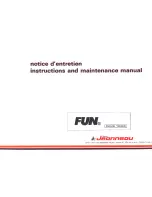
1-17
E
EJU11800
Rules of the Road
Yamaha watercraft is legally consid-
ered a powerboat. Operation of the
watercraft must be in accordance with
the rules and regulations governing the
waterway on which it is used.
Just as there are rules that apply when
you are driving on streets and highways,
there are waterway rules that apply when
you are operating your watercraft. These
rules are used internationally, and are also
enforced by the United States Coast Guard
and local agencies. You should be aware of
these rules, and follow them whenever you
encounter another vessel on the water.
Several sets of rules prevail according to
geographic location, but are all basically the
same as the International Rules of the
Road. The rules presented here in this
Owner’s/Operator’s Manual are condensed,
and have been provided for your conve-
nience only. Consult your local U.S. Coast
Guard Auxiliary or Department of Motor
Vehicles for a complete set of rules govern-
ing the waters in which you will be operating
your watercraft.
Steering and sailing rules
Whenever two vessels on the water meet
one another, one vessel has the right-of-
way; it is called the “stand-on” vessel. The
vessel that does not have the right-of-way is
called the “give-way” or “burdened” vessel.
These rules determine which vessel has the
right-of-way, and what each vessel should
do.
Stand-on vessel
The vessel with the right-of-way has the
duty to continue its course and speed,
except to avoid an immediate collision.
When you maintain your direction and
speed, the other vessel will be able to deter-
mine how best to avoid you.
Give-way vessel
The vessel which does not have the right-
of-way has the duty to take positive and
timely action to stay out of the way of the
stand-on vessel. Normally, you should not
cross in front of the vessel with the right-of-
way. You should slow down or change direc-
tions briefly and pass behind the other ves-
sel. You should always move in such a way
that the operator of the other vessel can see
what you are doing.
The General Prudential Rule regarding
the right-of-way is that if a collision appears
unavoidable, neither boat has the right-of-
way. Both boats must avoid the collision.
In other words, follow the standard rules
except when a collision will occur unless
both vessels try to avoid each other. If that is
the case, both vessels become give-way
vessels.
E_F1G10.book Page 17 Tuesday, July 12, 2005 10:26 AM
Содержание GP1300R WaveRunner 2006
Страница 2: ......
Страница 11: ...1 6 E EJU09980 Important labels EJU13510 Label location ...
Страница 12: ...1 7 E EJU13521 Warning labels 1 ...
Страница 13: ...1 8 E 6 2 3 5 4 7 ...
Страница 14: ...1 9 E EJU13540 Other labels 8 9 A 0 B D E C F ...
Страница 119: ...E 6 EJU11240 APPENDIX Limited warranty 6 1 YAMAHA EXTENDED SERVICE Y E S 6 3 Index 6 4 ...
Страница 126: ...Printed in USA Aug 2005 1 6 1 CR F1G F8199 13 E YAMAHA MOTOR CORPORATION USA ...















































